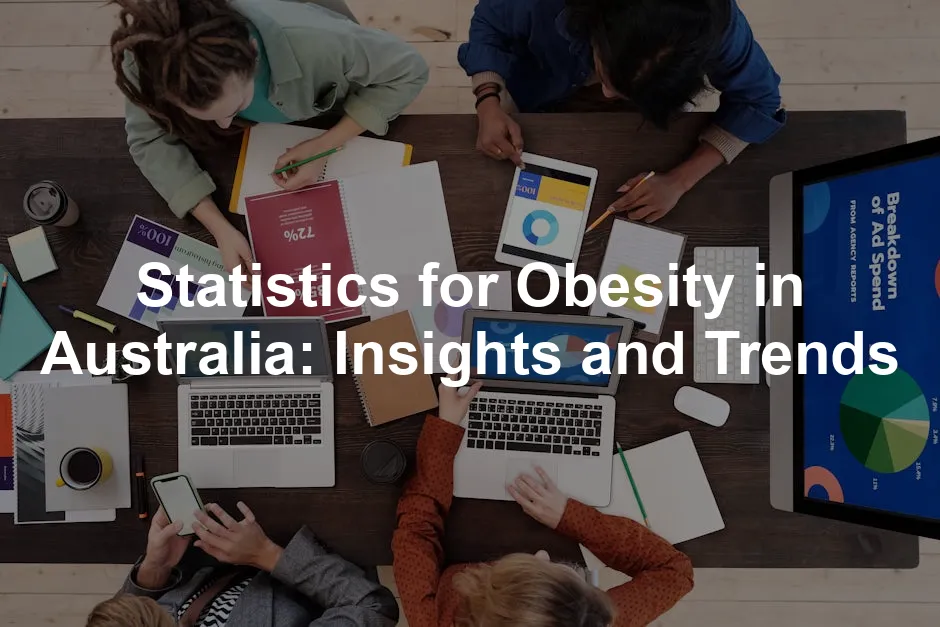Introduction
Obesity is a major public health concern in Australia. With the prevalence rising steadily, it impacts millions of Australians daily. In fact, the Australian Institute of Health and Welfare (AIHW) reports that two-thirds of adults are now classified as overweight or obese. This alarming trend aligns with global statistics, where obesity is increasingly recognized as an epidemic affecting various populations.
Australia faces unique challenges regarding obesity. Our lifestyle, dietary habits, and social environments contribute significantly to this issue. Fast food is readily available, and many Australians lead sedentary lifestyles, making it easy to pack on the pounds. Moreover, the COVID-19 pandemic has exacerbated these problems, with lockdowns leading to decreased physical activity and increased comfort eating. As a result, understanding the statistics surrounding obesity is crucial to addressing the issue effectively.
This article aims to provide a comprehensive overview of obesity statistics in Australia. We will explore detailed figures, trends, and the associated health implications. By understanding the scope of the problem, we can better inform public health policies and individual choices.

Understanding obesity statistics is essential for building a healthier Australia. obesity statistics in Australia
So why should we care about these statistics? They play a vital role in shaping public health initiatives. Accurate data helps policymakers create effective strategies to combat obesity. This, in turn, empowers individuals to make informed decisions about their health. Moreover, increased awareness can foster community support for healthier lifestyles. Ultimately, understanding obesity statistics is essential for building a healthier Australia.
To kickstart your journey towards a healthier lifestyle, consider investing in a Fitness Tracker Watch. This nifty gadget not only tracks your daily activities but also helps you set and achieve fitness goals. Plus, who doesn’t love a little tech to keep them motivated?
Current Statistics on Obesity in Australia
Prevalence of Obesity
Obesity rates in Australia are staggering. According to the latest data from the AIHW, 66% of adults aged 18 and over were living with overweight or obesity in 2022. This figure translates to approximately 12.5 million Australians carrying excess weight! Among these, 31.7% are classified as obese, while 34% fall into the overweight category.
Children are not immune to this crisis either. The AIHW reports that 26% of children and adolescents aged 2-17 were living with overweight or obesity in 2022. This number is particularly concerning, as childhood obesity often leads to health issues in adulthood. The prevalence among kids has been steadily rising, with a noticeable increase from 25% in 2017-18 to 28% in 2022 for those aged 5-17.
In addition to the overall figures, specific demographics reveal further insights. For instance, men are more affected than women, with 71.2% of males living with overweight or obesity, compared to 60.5% of females. Age also plays a crucial role, as obesity prevalence increases significantly with age. For example, 81.4% of men aged 65-74 and 78.1% of women in the same age group are classified as overweight or obese.
Geographic location is another important factor. Australians living in outer regional and remote areas face higher obesity rates, with a staggering 70.3% of adults in these regions classified as overweight or obese. In contrast, major cities report lower rates at 64%. Socioeconomic factors also contribute, with 68% of adults in the lowest socioeconomic areas affected compared to 60% in the highest.

These statistics highlight the urgent need for effective interventions. Understanding the widespread nature of obesity can help us address the underlying issues and drive collective action toward healthier lifestyles. Speaking of healthier lifestyles, meal prepping is a great way to stay on track. Check out these Meal Prep Containers to help you portion out your meals and avoid those late-night snacking temptations!
Breakdown by Demographics
Gender Differences
Obesity rates in Australia show a stark contrast between genders. In 2022, a whopping 71.2% of Australian men were living with overweight or obesity. On the flip side, 60.5% of women found themselves in the same boat. This indicates that men are more likely to struggle with weight issues compared to women. The gap isn’t just a minor detail; it reflects broader societal trends. Men often face different pressures and lifestyle choices that contribute to this disparity.

Age Group Analysis
As Australians age, their waistlines seem to expand. Obesity prevalence increases dramatically across age brackets. For instance, a staggering 81.4% of men aged 65-74 were classified as overweight or obese. Similarly, 78.1% of women in that same age range faced the same fate. In younger age groups, the numbers are less alarming but still concerning. Among those aged 18-24, the rate stands at 42.3% for men and 41.2% for women. Clearly, age plays a significant role in obesity trends, highlighting the need for targeted interventions as Australians grow older.
Geographic Variations
Urban vs. Rural
Where you live matters when it comes to obesity. In Australia, those in outer regional and remote areas face higher obesity rates, with 70.3% classified as overweight or obese. In contrast, major cities show lower rates, around 64%. This geographical disparity suggests that access to healthy food options and recreational facilities can significantly impact weight management. Urban dwellers might enjoy better access to health resources, while those in rural areas often contend with limited options. If you’re in a city, consider upgrading your kitchen with an Air Fryer to whip up healthier meals without sacrificing flavor!

Socioeconomic Factors
Socioeconomic status is another crucial factor influencing obesity rates. In the lowest socioeconomic areas, 68% of adults are living with overweight or obesity. This is compared to just 60% in higher socioeconomic regions. It’s clear that financial constraints can hinder access to nutritious foods and health services. Those in lower-income brackets may also face additional stressors that contribute to unhealthy lifestyle choices. Recognizing these disparities is vital for developing effective public health policies that address obesity holistically.

Childhood Obesity Trends
Childhood obesity in Australia is on the rise. The Australian Institute of Health and Welfare (AIHW) reported that in 2022, 26% of children aged 2-17 were living with overweight or obesity. This figure is particularly alarming. Just five years ago, in 2017-18, the rate was slightly lower at 25%. The trend shows a steady increase in childhood obesity rates, highlighting a growing public health challenge.
Obesity can lead to serious health complications. Children who are overweight are more likely to face obesity in adulthood. This creates a cycle of health issues, from diabetes to heart disease. It’s not just a number; it’s a future of potential health struggles for these children. To help combat this issue, consider investing in Child-Friendly Cookbooks that encourage kids to get involved in the kitchen and make healthier choices!
The factors contributing to this rise are complex. Sedentary lifestyles play a significant role. With more screen time and less outdoor play, kids are less active than ever. Additionally, the availability of unhealthy food options makes it easier for children to choose high-calorie, low-nutrition meals.

Schools and communities are beginning to take action. Programs focusing on nutrition and physical activity are becoming more common. However, the challenge remains. Addressing childhood obesity requires a collective effort from families, schools, and policymakers.
Future Projections
By 2035, adult obesity rates in Australia are projected to reach a staggering 47%. This prediction comes from the World Obesity Federation and paints a concerning picture for the nation’s health landscape. The increase reflects ongoing lifestyle changes and dietary habits that have become entrenched in Australian culture.
Factors contributing to this trend include dietary habits and physical activity levels. Many Australians are opting for convenience over health, leading to diets high in processed foods and sugars. Coupled with a decrease in physical activity, these habits create a perfect storm for weight gain. A great way to combat this is by using a Digital Food Scale to measure your portions accurately and make informed dietary choices!
Children are not immune to this trend. If current patterns continue, we may see a significant increase in childhood obesity rates as well. The importance of early intervention cannot be overstated. Addressing these issues now can help prevent a generation from facing severe health consequences later in life.

The path forward involves a multi-faceted approach. Encouraging healthier eating habits, promoting physical activity, and creating supportive environments are crucial. As the projections indicate, the time to act is now. The health of future generations depends on our actions today.
Economic Burden of Obesity
Obesity isn’t just a personal issue; it creates a colossal economic impact in Australia. The Australian Institute of Health and Welfare (AIHW) estimates that the cost of obesity to the healthcare system is staggering, reaching around $8.6 billion annually. This figure encompasses various healthcare services, including hospital admissions, medical treatments, and ongoing care for chronic conditions related to obesity.
Moreover, the economic burden doesn’t stop at healthcare costs. Productivity losses also play a significant role. When individuals struggle with obesity, they often face increased absenteeism and decreased productivity at work. This results in an estimated loss of around $2.2 billion due to reduced work capacity. The combination of these factors paints a grim picture of the overall economic impact of obesity on Australian society.

Government Response and Strategies
National Health Initiatives
To tackle the obesity crisis, Australia launched the National Obesity Strategy 2022-2032. The strategy sets ambitious goals, aiming to halt and reverse the rising prevalence of obesity among adults. Additionally, it targets a reduction of at least 5% in childhood obesity rates by 2030. The overarching aim is to empower individuals to make healthier choices while addressing the social and environmental factors that contribute to obesity.
Key strategies include enhancing community access to healthier food options and promoting physical activity. The government plans to collaborate with various sectors, including education, sports, and food industries, to create supportive environments that encourage healthier lifestyles. This multi-faceted approach recognizes that no single solution will suffice in combating obesity.

Public Health Campaigns
Public health campaigns are vital in raising awareness and promoting healthier choices among Australians. Initiatives like “Healthy Weight Week” and “Live Lighter” aim to educate the public on the importance of maintaining a healthy weight. These campaigns utilize eye-catching messages and relatable content to inspire individuals to make better dietary and lifestyle choices.
The government also emphasizes the importance of community engagement. Local initiatives, such as fitness programs and nutrition workshops, encourage active participation and foster a sense of belonging. By engaging communities, these campaigns aim to create a culture of health and wellness that permeates throughout society.

Community and Individual-Level Interventions
Role of Community Programs
Local initiatives play a crucial role in obesity prevention and management. Community programs centered around nutrition education, physical activity, and mental well-being have become increasingly popular. These programs often target specific demographics, such as children and low-income families, who may face unique challenges in maintaining a healthy lifestyle.
For instance, many local councils have introduced community gardens, allowing residents to grow their fruits and vegetables. This not only promotes healthy eating but also fosters social connections among community members. Furthermore, local fitness groups encourage physical activity, making exercise more accessible and enjoyable. And speaking of enjoyable exercise, have you tried using Jump Rope? It’s a fun way to get your heart pumping!

Individual Responsibility
While government strategies are essential, individual responsibility remains a key component in combating obesity. Making informed choices about diet and exercise can significantly impact personal health. Individuals are encouraged to embrace healthier eating habits, engage in regular physical activity, and seek support from healthcare professionals when needed.
By understanding the importance of personal choices, Australians can contribute to the collective effort of reducing obesity rates. After all, small changes in daily habits can lead to significant improvements in overall health and well-being.

Individual Responsibility
In the battle against obesity, personal choices play a pivotal role. It’s easy to blame fast food chains or the latest binge-worthy streaming series for our expanding waistlines. However, the power to change lies within us. Yes, the struggle is real, but so is the ability to make smarter choices.
Imagine swapping that sugary soda for a refreshing glass of water. Sounds simple, right? Yet, this small change can lead to significant weight loss over time. It’s not about strict diets or exhausting workouts; it’s about creating healthier habits. Cook more meals at home, embrace fresh fruits and veggies, and say goodbye to mindless snacking. You’ll be amazed at how these choices can add up. And if you need a little help, consider a Healthy Cookbook for Weight Loss to guide you!
Moreover, physical activity isn’t just for gym enthusiasts. It can be as easy as taking the stairs instead of the elevator or going for a brisk walk during your lunch break. Finding ways to incorporate movement into your daily routine can help you shed those extra kilos without it feeling like a chore. And for those who love a bit of a challenge, Fitness Challenge Cards can add some fun to your workout routine!
Support systems are also crucial. Discuss your health goals with family and friends. When you have a cheer squad, it’s easier to stay motivated. Joining community fitness programs or local health workshops can provide both camaraderie and accountability. Remember, you’re not in this alone!
Finally, don’t underestimate the power of education. Understanding nutrition labels, portion sizes, and healthy cooking methods can empower you to make more informed choices. Knowledge is a game changer! The more you know, the better equipped you’ll be to tackle the obesity epidemic head-on.
In short, individual responsibility in combating obesity is about making conscious choices, staying active, leveraging support, and educating yourself. Every step counts, and every choice matters. Together, we can create a healthier Australia, one informed decision at a time.

Conclusion
Obesity in Australia is a pressing public health issue that demands our attention. As we’ve discussed, a staggering 66% of adults and 26% of children are classified as overweight or obese. These figures aren’t just numbers; they represent real lives affected by serious health risks, including diabetes and heart disease. The trends show a worrying increase, with projections indicating that by 2035, nearly 47% of adults could be living with obesity.
The urgent need for action is clear. Governments, communities, and individuals must collaborate to address this crisis. Public health initiatives, such as the National Obesity Strategy, aim to reverse these alarming trends. Yet, for these strategies to succeed, we all have a role to play. Engage with local health programs, participate in community activities, and encourage conversations about healthy lifestyles.
It’s time to take personal responsibility for our health. Simple changes in diet and physical activity can lead to significant improvements. Start with small, manageable goals, and build from there. Every healthy choice contributes to a collective effort toward a healthier future. And don’t forget to hydrate with a Water Bottle with Time Marker to track your intake!
Looking ahead, continuous monitoring and research on obesity statistics in Australia are essential. Understanding the evolving landscape will help tailor interventions to meet the needs of diverse communities. Together, we can combat this epidemic and pave the way for healthier generations to come. Let’s not just talk about change—let’s be the change!

FAQs
What is the definition of obesity?
Obesity is defined as having a Body Mass Index (BMI) of 30 or higher. BMI is calculated using weight and height to categorize individuals into different weight classes. A BMI between 25 and 29.9 indicates overweight, while a BMI below 18.5 is considered underweight.
How can I measure my body weight status?
To calculate your BMI, follow these steps: 1. Weigh yourself in kilograms. 2. Measure your height in meters. 3. Use the formula: BMI = weight (kg) / (height (m) x height (m)). Interpreting the results: a BMI below 18.5 is underweight, 18.5 to 24.9 is normal, 25 to 29.9 is overweight, and 30 or higher is obese.
What are the main causes of obesity in Australia?
Several factors contribute to obesity in Australia. Dietary habits play a significant role, with high consumption of processed foods and sugary drinks. Physical inactivity is another major factor, exacerbated by sedentary lifestyles. Socioeconomic factors, such as income and education, also influence access to healthy food options and opportunities for exercise.
What are some effective strategies to combat obesity?
Here are practical tips to manage weight: – Focus on whole foods: Incorporate more fruits, vegetables, and whole grains into your diet. – Stay active: Aim for at least 150 minutes of moderate exercise weekly, such as walking, cycling, or swimming. – Educate yourself: Learn about nutrition labels and portion sizes. – Seek support: Join community programs or connect with friends and family to stay motivated.
Where can I find more information on obesity statistics?
For reliable statistics on obesity in Australia, visit reputable sources such as the Australian Institute of Health and Welfare (AIHW) and the Australian Bureau of Statistics (ABS). Both provide comprehensive data and reports on health trends and statistics.
Please let us know what you think about our content by leaving a comment down below!
Thank you for reading till here 🙂
All images from Pexels




